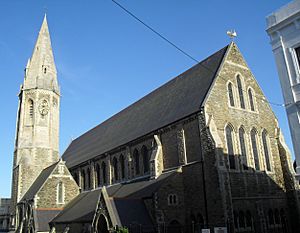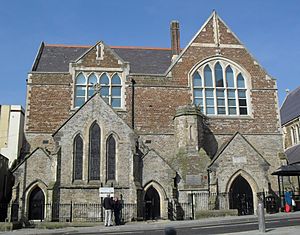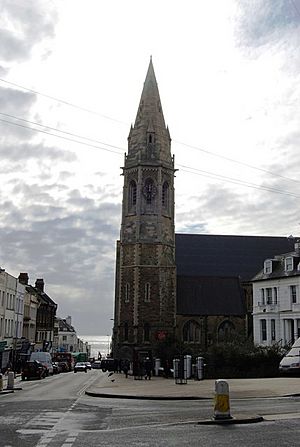Christ Church, St Leonards-on-Sea facts for kids
Quick facts for kids Christ Church |
|
|---|---|
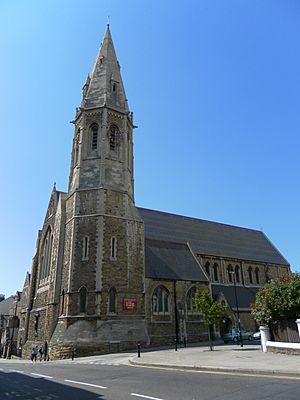
The church from the northeast
|
|
| 50°51′14″N 0°33′33″E / 50.8538°N 0.5593°E | |
| Location | London Road/Silchester Road, St Leonards-on-Sea, Hastings, East Sussex TN37 6AY |
| Country | England |
| Denomination | Anglican |
| Churchmanship | Anglo-Catholic |
| Website | www.christchurchstleonards.co.uk |
| History | |
| Status | Parish church |
| Founded | 1860 (original church); 1873 (present church) |
| Founder(s) | Lady St John |
| Dedicated | 13 May 1875 |
| Consecrated | 20 November 1884 |
| Architecture | |
| Functional status | Active |
| Heritage designation | Grade II* |
| Designated | 14 September 1976 |
| Architect(s) | Arthur Blomfield |
| Style | Early English Gothic Revival |
| Completed | 9 September 1860 (original church); 5 February 1895 (present church, including tower and spire) |
| Specifications | |
| Capacity | 1,000 |
| Other dimensions | Tower height: 119+3⁄4 feet (36.5 m) |
| Number of spires | 1 |
| Spire height | 64+1⁄2 feet (19.7 m) |
| Materials | Sandstone, rock and rubble |
| Administration | |
| Parish | St Leonards-on-Sea: Christ Church and St Mary Magdalen [sic] |
| Deanery | Hastings |
| Archdiocese | Lewes and Hastings |
| Diocese | Diocese of Chichester |
Christ Church is an Anglican church located in St Leonards-on-Sea, a town that is part of Hastings in East Sussex, England. It first opened in 1860 as the third Anglican church in the area. It was built to serve the growing number of people moving to St Leonards-on-Sea. It also welcomed poorer residents who couldn't afford to pay for seats in other churches.
The original church was replaced by a much larger one built right next to it between 1873 and 1875. This new church was designed by a famous architect named Sir Arthur Blomfield. His design is in the Gothic Revival style, which looks like old medieval churches. Christ Church is a well-known landmark on one of St Leonards-on-Sea's main roads. It is still an active church today and is known for its strong Anglo-Catholic traditions. Experts have called it one of Blomfield's best works in Sussex. Historic England has given Christ Church a special Grade II* listing because of its important history and architecture.
Contents
The Church's Story
How St Leonards-on-Sea Grew
The town of Hastings started way back in the 8th century. It became an important trading place and a main port during the Middle Ages. By the 13th century, it had seven churches. However, most of these churches disappeared over time.
After a quiet period, Hastings started to grow again in the 18th century. By the 1820s, it was a popular holiday spot. Around this time, a builder named James Burton bought land nearby. He created a brand new, fancy town called St Leonards-on-Sea. This new town quickly became popular and grew as big as Hastings itself.
Why a New Church Was Needed
By 1858, St Leonards-on-Sea had two Anglican churches: St Leonard's and St Mary Magdalene's. However, these churches charged money for seats. This meant that many working-class people, like servants, shop workers, and railway builders, couldn't afford to go. They needed a church where they could worship for free. The closest free church was several miles away.
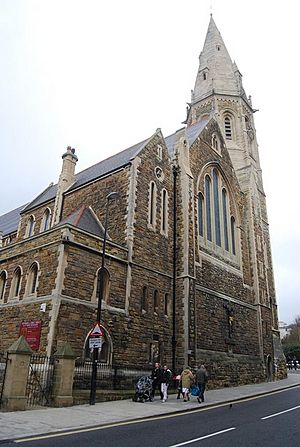
Lady St John, whose full name was Louisa Boughton, was a kind lady who wanted to help. She was worried about the people who couldn't find a place to worship. So, she decided to pay for a brand new church in central St Leonards-on-Sea where everyone could attend for free.
This first Christ Church opened on September 9, 1860. It was built from sandstone in the Early English Gothic Revival style and had a small bell-tower. The stone for the church even came from a nearby quarry.
Building the Bigger Church
In 1863, Lady St John's son, Rev. Charles Lyndhurst Vaughan, became the first permanent vicar of Christ Church. He was very dedicated and helped the church grow. In 1865, he started another church nearby called St John the Evangelist's Church, which is still active today.
By 1873, the original Christ Church was often full. Rev. Vaughan believed they needed an even bigger church that could hold 1,000 people. So, he started building a new, much larger church right next to the old one. The foundation stone was laid on November 6, 1873.
The new church was designed by Sir Arthur Blomfield, who was famous for designing many churches in the Victorian era. He often used the Early English Gothic Revival style. The church was dedicated on May 13, 1875, even though it wasn't completely finished. The tower and spire were added later, completed on February 5, 1895.
Changes Over Time
Over the years, more improvements were made to the church. In the early 1900s, beautiful stained glass windows were installed. A new font was added, and a special monument was placed to remember Rev. Vaughan, who had passed away.
The church was extended in 1919–20 to include an organ chamber. A memorial chapel, called the Chapel of the Holy Souls, was also built inside the church in 1921 to honor those who served in the war. More changes were made in 1933 to make the inside of the church even more beautiful.
During World War II, St Leonards-on-Sea was bombed often, but Christ Church was only slightly damaged. After the war, some repairs were needed, especially to the roof. Many important people visited the church to help raise money for these repairs.
In 1980, St Mary Magdalene's Church nearby closed. Christ Church's parish (its local area) was then expanded to include the area that St Mary Magdalene's used to serve.
What the Church Looks Like
The new Christ Church, designed by Arthur Blomfield, is much larger than the first one. It's built mostly from rubble and sandstone. The church has a long main area called a nave, with side aisles, a chancel (the area around the altar), and two smaller chapels. Because the land slopes, some rooms like the vestries are actually below the main church.
The church is very long and tall inside. The impressive east end faces London Road and has a large window with five tall, narrow lights. The tower, which is partly made of smooth stone, has four sections and an eight-sided top part where the bells are. The bells were installed in 1894 and first rang on February 23, 1895. The tower is about 120 feet (36.5 meters) tall, and the spire on top adds another 64 feet (19.6 meters). With the cross on top, the total height is about 189 feet (57.6 meters)!
Inside the Church
The two chapels inside the church are decorated with beautiful paintings called frescoes. The Lady Chapel has paintings of Jesus, Mary, and female saints. The Chapel of the Holy Souls, which is a war memorial, shows scenes like Abraham meeting Melchizedek. The main altar area also has frescoes of saints.
The church has many "outstanding" stained glass windows. The large east window, for example, shows images of angels, apostles, saints, and wise men, all worshipping in a heavenly scene.
Christ Church Today
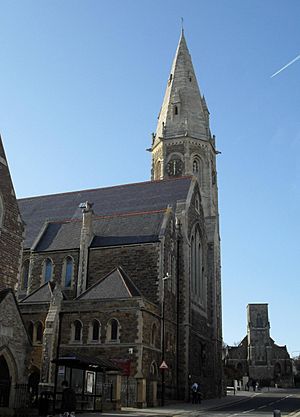
Christ Church was given a Grade II* listing by Historic England on September 14, 1976. This means it's a very important building with special historical and architectural value. In February 2001, it was one of 13 buildings in Hastings with this high listing.
The church's parish covers the central part of St Leonards-on-Sea. It includes the area that used to belong to St Mary Magdalene's Church.
Christ Church holds many services every week, all following the Anglo-Catholic tradition. There is a daily service called Mass, and two Masses on Sunday mornings. They also offer other prayer services. The church has asked for special guidance from a bishop who supports their views on not ordaining women as priests.
The original church building from 1860 is now used as a parish hall. It's also used for some church school activities. It was updated in 2002.
Christ Church remains one of the most easily recognized buildings in St Leonards-on-Sea. London Road, where it stands, is known for its interesting 19th-century church buildings. The old and new Christ Churches stand together, and further up the hill, you can see the former St Leonards-on-Sea Congregational Church, which closed in 2008.
See also


